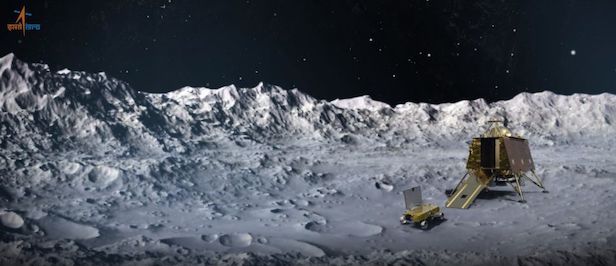Here’s where India’s Chandrayaan-2 will land near the Moon’s south pole (and why)
Chandrayaan-2 was placed into lunar orbit on 20 August 2019

An artist’s depiction of India’s Chandrayaan-2 lander and rover on the surface of the Moon, near its south pole. Image credit: ISRO
It doesn’t have a name, at least not yet. But in just a few days, if all goes well, it could become one of the most important places on the Moon’s surface.
That spot is a highland that rises between two craters dubbed Manzinus C and Simpelius N. On a grid of the Moon’s surface, it would fall at 70.9 degrees south latitude and 22.7 degrees east longitude. It’s about 600 kilometres (375 miles) from the south pole.
And it’s the preferred landing site for India’s Moon mission, Chandrayaan-2, which is scheduled to touch down on 6 September 2019, between 4:00p.m. and 5:00p.m. EDT (7 September, between 1:30a.m. and 2:30a.m. local time at mission control in India). The Indian Space Research Organisation (ISRO), which oversees the mission, also has a backup site selected, at 67.7 degrees south latitude and 18.4 degrees west longitude.
Either way, if the landing goes smoothly, the site will become the southernmost spot on the Moon to be visited by a spacecraft.
All of NASA’s Apollo landing sites, where astronauts explored the surface, are clustered near the equator on the near side, where it’s easiest and safest to land. That has skewed scientists’ understanding of the samples those astronauts brought back – it’s sometimes difficult to tell whether a characteristic appears in all the samples because it is universal in the Moon’s surface or simply because it happens to prevail in this region.
Even China’s Chang’e-4 mission, which became the first spacecraft to touch down on the farside of the Moon, did so at a latitude of about 45 degrees south.
Choosing different lunar landing sites is important for science not solely in order to build a more complete picture of the Moon’s geology: The south pole is particularly intriguing. That’s where instruments on board this mission’s predecessor, the Chandrayaan-1 orbiter, detected slabs of water ice buried in the always-shadowed craters near the Moon’s south pole.
Chandrayaan-2 is designed to build on that detection, with a mission that cost £120 million ($150 million), according to Science, the new outlet affiliated with the research journal of the same name. The current project added lander and rover vehicles to the second-generation orbiter.
These two vehicles will touch down just after dawn at the landing site, allowing them to work for about 14 days before the harsh lunar night freezes them. ISRO will attempt to revive the duo when the Sun rises again, but the robots weren’t designed to survive the night.
The orbiter component of the mission will continue working for about a year, orbiting from pole to pole in order to augment the hoped-for discoveries of the lander and rover.
Keep up to date with the latest news in All About Space – available every month for just £4.99. Alternatively you can subscribe here for a fraction of the price!




